No edit summary |
(→BIOS string: to be continued) |
||
| Line 98: | Line 98: | ||
== BIOS string == | == BIOS string == | ||
The BIOS string | The BIOS string was first introduced with [[AMIBIOS 2.2x]] for easy identification of each BIOS revision (by the OEM/manufacturer) and is often seen during POST near the very bottom of the screen. The string is formatted to contain various sections, with each containing information for a different field. Known codes for these sections are given in the [[Document:AMIBIOS string codes|List of codes for BIOS strings]] (also available at the bottom of this page section). The formats have been changed various times with some new releases of AMIBIOS. | ||
=== AMIBIOS 2.2x === | === AMIBIOS 2.2x === | ||
'''MMMM:''' Manufacturer/OEM identification code, '''SSSSSS:''' BIOS | '''MMMM:''' Manufacturer/OEM identification code, '''SSSSSS:''' BIOS version release date | ||
<code>MMMM-SSSSSS</code> | <code>MMMM-SSSSSS</code> | ||
| Line 107: | Line 107: | ||
'''Example string''': 1406-061286 | '''Example string''': 1406-061286 | ||
This string is for | This string is for an AMIBIOS 2.2x version (released on June 12, 1986, "061286") for Flying Triumph Co. Ltd. ("1406"). | ||
=== AMI Plus BIOS === | === AMI Plus BIOS === | ||
'''D:''' CMOS setup type, '''CCC:''' Chipset type, '''MMMM:''' Manufacturer/OEM identification code, '''SSSSSS:''' BIOS | '''D:''' CMOS setup type, '''CCC:''' Chipset type, '''MMMM:''' Manufacturer/OEM identification code, '''SSSSSS:''' BIOS version release date, '''KK:''' Keyboard controller (KBC) ID (with second character indicating the model). | ||
<code>DCCC-MMMM-SSSSSS-KK</code> | <code>DCCC-MMMM-SSSSSS-KK</code> | ||
'''Note:''' The CMOS setup type code can be two characters for "DE" in case the BIOS contains both extended setup and built-in diagnostics. | '''Note:''' The CMOS setup type code can also be two characters for "DE" in case the BIOS contains both extended setup and built-in diagnostics. | ||
'''Example string''': D286-1277-043089-K0 | '''Example string''': D286-1277-043089-K0 | ||
This string is for | This string is for an AMI Plus BIOS version (released on April 30, 1986, "043089") with built-in diagnostics ("D") for a machine with a discrete 286 logic ("286") and a default/unknown keyboard controller (K"0") for Trangg Bow Co. ("1277"). | ||
=== | === AMI Hi-Flex BIOS, AMIBIOS 4, AMIBIOS 5 and early versions of AMIBIOS 6 === | ||
'''C:''' Processor architecture, '''R:''' ROM size, '''MMMM:''' Manufacturer/OEM identification code, '''FFFFFFFF:''' BIOS feature identification (often 00101111), '''SSSSSS:''' BIOS compile date OR subcore release date, '''DDDDDDDD:''' BIOS identifier | '''C:''' Processor architecture, '''R:''' ROM size, '''MMMM:''' Manufacturer/OEM identification code, '''FFFFFFFF:''' BIOS feature identification (often 00101111), '''SSSSSS:''' BIOS compile date OR subcore release date, '''DDDDDDDD:''' BIOS identifier, '''K:''' Keyboard controller (KBC) ID | ||
<code>CR-VVVV-00MMMM-FFFFFFFF-SSSSSS-DDDDDDDD | <code>CR-VVVV-00MMMM-FFFFFFFF-SSSSSS-DDDDDDDD-K</code> | ||
'''Example string''': 61-1108-001169-00101111-071595-440BX/ZX-1440B000-H | '''Example string''': 61-1108-001169-00101111-071595-440BX/ZX-1440B000-H | ||
Revision as of 17:40, 28 April 2024
AMIBIOS is a personal computer BIOS developed by AMI (American Megatrends), which has bought it's rights from Access Methods Inc. in around 1986. Earliest known mentions of AMIBIOS are from 1985, with the earliest known version likely being released around that time.
While it is still used on some current day industrial/embedded platforms (such as ones based on the Vortex86 SoC), it has been fully phased out on modern consumer platforms in favor of (U)EFI-based solutions such as Aptio (which is it's successor), InsydeH2O and Phoenix SecureCore. However, most older instances of Aptio released still included an embedded version of AMIBIOS 8 as a component module for CSM/legacy boot. With CSM being discontinued by Intel in 2020 however, the module is no longer present.[1]
Purchase from Access Methods
Main page: American Megatrends
Access Methods Inc. created AMIBIOS in 1985. Same year, Access Methods' owners (Subramonian Shankar and Pat Sarma) found a new company from the funds raised with it. It was called Quintessential Consultants Inc. (QCI), which then got renamed to American Megatrends Inc. (AMI) to keep the "AMIBIOS" acronym. American Megatrends then bought AMIBIOS from Access Methods next year.
List of known versions
All versions made before AMI Plus BIOS were released by Access Methods, although some of these versions later received new cores (revisions) from American Megatrends and those had their copyright (instead of Access Methods').
Almost all instances of versions from AMIBIOS 2.2x to AMIBIOS 6 and AMIBIOS 07.00.10 can be identified by the date in the POST string, which (unlike on AMIBIOS 07.00.xx and 8) is actually fixed to the initial AMIBIOS release date. However these dates were occasionally modified by OEMs/motherboard manufacturers to reflect the BIOS compile or revision release date instead, especially during the pre-WinBIOS (AMIBIOS 4) era. Since AMIBIOS 07.00.xx (excluding AMIBIOS 07.00.10), the date in the string reflects the specific revision's compile date instead and therefore cannot be used to determine the initial release date of the AMIBIOS version.
Notice: Due to lack of proper information and reference guides, names for all versions made before AMI Hi-Flex BIOS are assumed based on a few unofficial sources online and they may not reflect the actual BIOS version names. As more information is discovered, these may be corrected.
| Version name | First release date | POST screen (if available) | Notes |
|---|---|---|---|
| "Rev-X2-03" (AMIBIOS 2.03?) | Most likely 1985 or early 1986 | 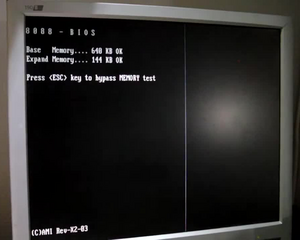
|
Possibly the earliest known version. AMIBIOS 2.03 is a possible name, although unconfirmed. |
| AMIBIOS 2.2x(?) | 1986 | 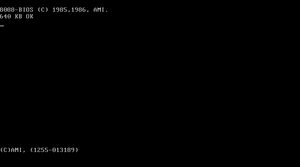
|
The name is assumed based on unofficial information and may not be correct. |
| AMI Plus BIOS(?) | 1987 | 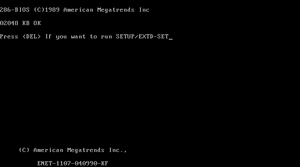
|
The name is assumed based on unofficial information and may not be correct. Sometimes (unofficially) also called AMI Pre-Color BIOS by some enthusiasts as it has a black and white setup utility and was released before Hi-Flex BIOS (which is often also unofficially called AMI Color BIOS, due to it's colorful setup utility). |
| AMI Hi-Flex BIOS | 1990 | 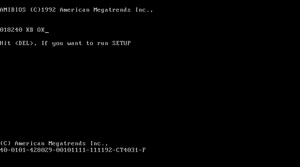
|
Not to be confused with the Hi-Flex Setup Utility on AMIBIOS 6 and 07.00.10, which was named after it. Unofficially also called AMI Color BIOS by some enthusiasts (due to its colorful setup utility). It was likely also called AMIBIOS 3 internally, although unconfirmed. |
| AMI WinBIOS (AMIBIOS 4) | 1993 | 
|
Often referred to as AMI WinBIOS, not to be confused with the WinBIOS Setup Utility on AMIBIOS 6 (which was named after it). Often known with the core date 121593 (December 15, 1993) in string, however other core dates also exist.
|
| AMIBIOS 5 | 1994 | 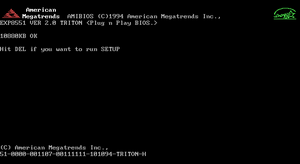
|
Visually looks almost identical to AMIBIOS 4, although contains initial bug fixes and new features. Often known with the core date 101094 (October 10, 1994) in string.
|
| AMIBIOS 6 | 1995 | 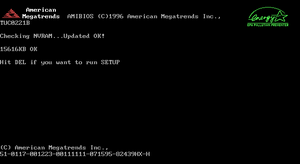
|
Often known with the core date 071595 in string, however other core dates also exist.
|
| AMI eBIOS Version 1 | Unknown | Not available. | Currently no information is available and it might not actually exist, however it is assumed to exist due to the existence of eBIOS 02.00.xx. |
| AMIBIOS 07.00.xx / 07.00.00 | 1999 | 
|
Not to be confused with AMIBIOS 07.00.10 [with date 040201 (April 2, 2001) in string]. Probably an early development release of AMIBIOS 8, which might have initially been called AMIBIOS 7.
|
| AMI eBIOS 02.00.xx | 2000 or 1999 | 
|
Assumed to be a variant of AMIBIOS 07.00.xx for embedded systems. Not much else is known about it. |
| AMIBIOS 7 (07.00.10) | 2001 | 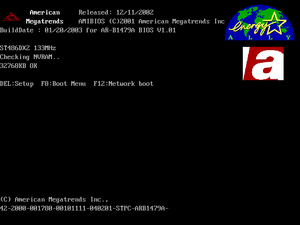
|
Not to be confused with AMIBIOS 07.00.xx/07.00.00. Often known with the core date 040201 (April 2, 2001) in string. Assumed to be an update based on the AMIBIOS 6 codebase.
|
| 64-Bit AMIBIOS Version 1 | 2001(?) | Not available. | Currently no information is available and it might not actually exist, however it is assumed to exist due to the existence of 64-Bit AMIBIOS 02.00.00. |
| AMIBIOS 8 | 2001 | 
|
Last standalone version of AMIBIOS. Most likely the final product for AMIBIOS 07.00.xx/07.00.00. Although first released in 2001, it was not used widely until a couple years later. |
| 64-Bit AMIBIOS 02.00.00 | 2003(?) | Not available. | Assumed to be a variant of AMIBIOS 8 or 07.00.xx for Itanium based servers. Only known instance is on the SuperMicro MBD-i2DML-8G2-O Intel Itanium motherboard. |
| AMIBIOS 9 | Unknown | Not available. | Used on Microsoft Hyper-V. Assumed to be a special version or code fork for it, or possibly the name given to emulated BIOS for CSM mode in AMI Aptio. |
BIOS string
The BIOS string was first introduced with AMIBIOS 2.2x for easy identification of each BIOS revision (by the OEM/manufacturer) and is often seen during POST near the very bottom of the screen. The string is formatted to contain various sections, with each containing information for a different field. Known codes for these sections are given in the List of codes for BIOS strings (also available at the bottom of this page section). The formats have been changed various times with some new releases of AMIBIOS.
AMIBIOS 2.2x
MMMM: Manufacturer/OEM identification code, SSSSSS: BIOS version release date
MMMM-SSSSSS
Example string: 1406-061286
This string is for an AMIBIOS 2.2x version (released on June 12, 1986, "061286") for Flying Triumph Co. Ltd. ("1406").
AMI Plus BIOS
D: CMOS setup type, CCC: Chipset type, MMMM: Manufacturer/OEM identification code, SSSSSS: BIOS version release date, KK: Keyboard controller (KBC) ID (with second character indicating the model).
DCCC-MMMM-SSSSSS-KK
Note: The CMOS setup type code can also be two characters for "DE" in case the BIOS contains both extended setup and built-in diagnostics.
Example string: D286-1277-043089-K0
This string is for an AMI Plus BIOS version (released on April 30, 1986, "043089") with built-in diagnostics ("D") for a machine with a discrete 286 logic ("286") and a default/unknown keyboard controller (K"0") for Trangg Bow Co. ("1277").
AMI Hi-Flex BIOS, AMIBIOS 4, AMIBIOS 5 and early versions of AMIBIOS 6
C: Processor architecture, R: ROM size, MMMM: Manufacturer/OEM identification code, FFFFFFFF: BIOS feature identification (often 00101111), SSSSSS: BIOS compile date OR subcore release date, DDDDDDDD: BIOS identifier, K: Keyboard controller (KBC) ID
CR-VVVV-00MMMM-FFFFFFFF-SSSSSS-DDDDDDDD-K
Example string: 61-1108-001169-00101111-071595-440BX/ZX-1440B000-H
This string is for a 11.08 revision ("1108") 128 KB ("1") size AMIBIOS 6 ("071595", main subcore for it) for a motherboard for 686 architecture processors ("6") with Intel 440BX or 440ZX chipset ("440BX/ZX") and an AMIKEY-2 clone keyboard controller ("H") made by MSI ("1169").
List of known codes for BIOS strings
Click "Expand" to view.
- ↑ https://www.intel.com/content/www/us/en/content-details/630266/removal-of-legacy-boot-support-for-intel-platforms-technical-advisory.html | Note: Although this document was published in 2023, it clearly mentions legacy boot being discontinued in 2020.